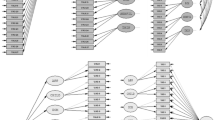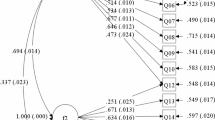Abstract
Norm-violating behavior is characterized by clear social norms which prescribe the non-occurrence of that behavior. From the theoretical framework of Allport it is derived that specifically norm-conformation is consistent, while violating norms is expected to be inconsistent and more circumstantial. This is in contrast to test-theoretic approaches of delinquent behavior that assume that various norm-violating responses form a consistent answer pattern that is scalable and reliable. In this study we study the inter-correlations, scalability and reliability of norm-violating responses and their relation with the reduction of zero observations. In concordance with Allport’s view it is expected that different norm-violating self-report items have limited interrelatedness and are limited in scalability and reliability in the norm-violating sub-population. The NLSY98 self-report data show that a large majority of respondents (69 %) conform systematically to all ten different norms, while only nine percent admits more than two different violations. The results show that in subsamples of norm-violating respondents, the correlations between items become closer to zero, dependent on the amount of zero reduction. Furthermore, both Loevinger’s H coefficient of scalability and scale reliability become unsatisfactorily low, when 35 % or more strict norm-conforming subjects are removed.



Similar content being viewed by others
References
Allport, F.H.: The J-curve hypothesis of conforming behavior. J. Soc. Psychol. 5, 141–183 (1934)
Allport, F.H.: Rule and custom as individual variations of behavior distributed upon a continuum of conformity. Am. J. Sociol. 44(6), 897–921 (1939)
Bauer, D.J., Curran, P.J.: Distributional assumptions of growth mixture models: Implications for overextraction of latent trajectory classes. Psychol. Methods 8(3), 338 (2003)
Cameron, A.C., Trivedi, P.K.: Regression Analysis of Count Data. Cambridge University Press, Cambridge (1998)
Clarke, R.V.: The distribution of deviance and exceeding the speed limit. Br. J. Criminol. 36(2), 169 (1996)
Cortina, J.M.: What is coefficient alpha? An examination of theory and applications. J. Appl. Psychol. 78(1), 98 (1993)
Ghosh, S., Gelfand, A.E., Zhu, K., Clark, J.S.: The k-ZIG: Flexible modeling for zero-inflated counts. Biometrics 68, 878–885 (2012)
Goldstein, H., Wood, R.: Five decades of item response modelling. Br. J. Math. Stat. Psychol. 42(2), 139–167 (1989)
Hindelang, M.J., Hirschi, T., Weis, J.G.: Measuring Delinquency. Sage Publications, Beverly Hills (1981)
Huizinga, D., Elliott, D.S.: Reassessing the reliability and validity of self-report delinquency measures. J. Quant. Criminol. 2(4), 293–327 (1986). doi:10.1007/BF01064258
Junger-Tas, J., Marshall, I.H.: The self-report methodology in crime research. Crime Justice 291–367 (1999)
Lambert, D.: Zero-inflated Poisson regression, with an application to defects in manufacturing. Technometrics 34(1), 1–14 (1992)
Loevinger, J.: The technic of homogeneous tests compared with some aspects of “scale analysis” and factor analysis. Psychol. Bull. 45(6), 507 (1948)
Min, Y., Agresti, A.: Random effect models for repeated measures of zero-inflated count data. Stat. Model. 5(1), 1 (2005)
Moore, W., Pedlow, S., Krishnamurty, P., Wolter, K., Chicago, I.L.: National Longitudinal Survey of Youth 1997 (NLSY97). National Opinion Research Center, Chicago, IL (2000)
Nagin, D.S., Land, K.C.: Age, criminal careers, and population heterogeneity: Specification and estimation of a nonparametric, mixed Poisson Model. Criminology 31(3), 327–362 (1993)
Osgood, D.W., McMorris, B.J., Potenza, M.T.: Analyzing multiple-item measures of crime and deviance I: Item response theory scaling. J. Quant. Criminol. 18(3), 267–296 (2002)
Perumean-Chaney, S.E., Morgan, C., McDowall, D., Aban, I.: Zero-inflated and overdispersed: What’s one to do? J. Stat. Comput. Simul. http://www.tandfonline.com/doi/abs/10.1080/00949655.2012.668550 (2012). Accessed 10 Jan 2013
Piquero, A.R., Macintosh, R., Hickman, M.: The validity of a self-reported delinquency scale: Comparisons across gender, age, race, and place of residence. Sociol. Methods Res. 30(4), 492 (2002)
Raudenbush, S.W., Johnson, C., Sampson, R.J.: A multivariate, multilevel Rasch model with application to self-reported criminal behavior. Sociol. Methodol. 169–211 (2003)
Sijtsma, K.: On the use, the misuse, and the very limited usefulness of Cronbach’s alpha. Psychometrika 74(1), 107–120 (2009)
Simpson, E.H.: The interpretation of interaction in contingency tables. J. R. Stat. Soc. Ser. B Methodol. 13(2), 238–241 (1951)
Slymen, D.J., Ayala, G.X., Arredondo, E.M., Elder, J.P.: A demonstration of modeling count data with an application to physical activity. Epidemiol. Perspect. Innov. 3(1), 3 (2006)
Thornberry, T.P., Krohn, M.D.: Comparison of self-report and official data for measuring crime. Measurement Problems in Criminal Justice Research, pp. 43–94. National Academies Press, Washington, DC (2003)
van der Ark, L.A., Croon, M.A., Sijtsma, K.: Mokken scale analysis for dichotomous items using marginal models. Psychometrika 73(2), 183–208 (2008)
Author information
Authors and Affiliations
Corresponding author
Appendix
Appendix
The relationship between mean, variance, covariance and correlation with and without a proportion zero-inflation of \(\pi \).
Let there be a zero-inflated variable with \(n\) observations, a proportion zero-inflation of \(\pi \) and an underlying not inflated distribution with \(\tilde{n}\) observations, mean \(\tilde{\mu }\) and variance \(\tilde{\sigma }^{2}\).
Derivation of formula (3)
The variance of a zero-inflated variable \(y\) with \(n\) observations and mean \(\mu \) is:
and
The covariance formula can be derived in similar fashion.
and
The Pearson product moment correlation is
Rights and permissions
About this article
Cite this article
Landsheer, J.A. The co-occurrence of self-observed norm-conforming behavior, reduction of zero observations and remaining measurement quality. Qual Quant 48, 2647–2656 (2014). https://doi.org/10.1007/s11135-013-9914-5
Received:
Accepted:
Published:
Issue Date:
DOI: https://doi.org/10.1007/s11135-013-9914-5




